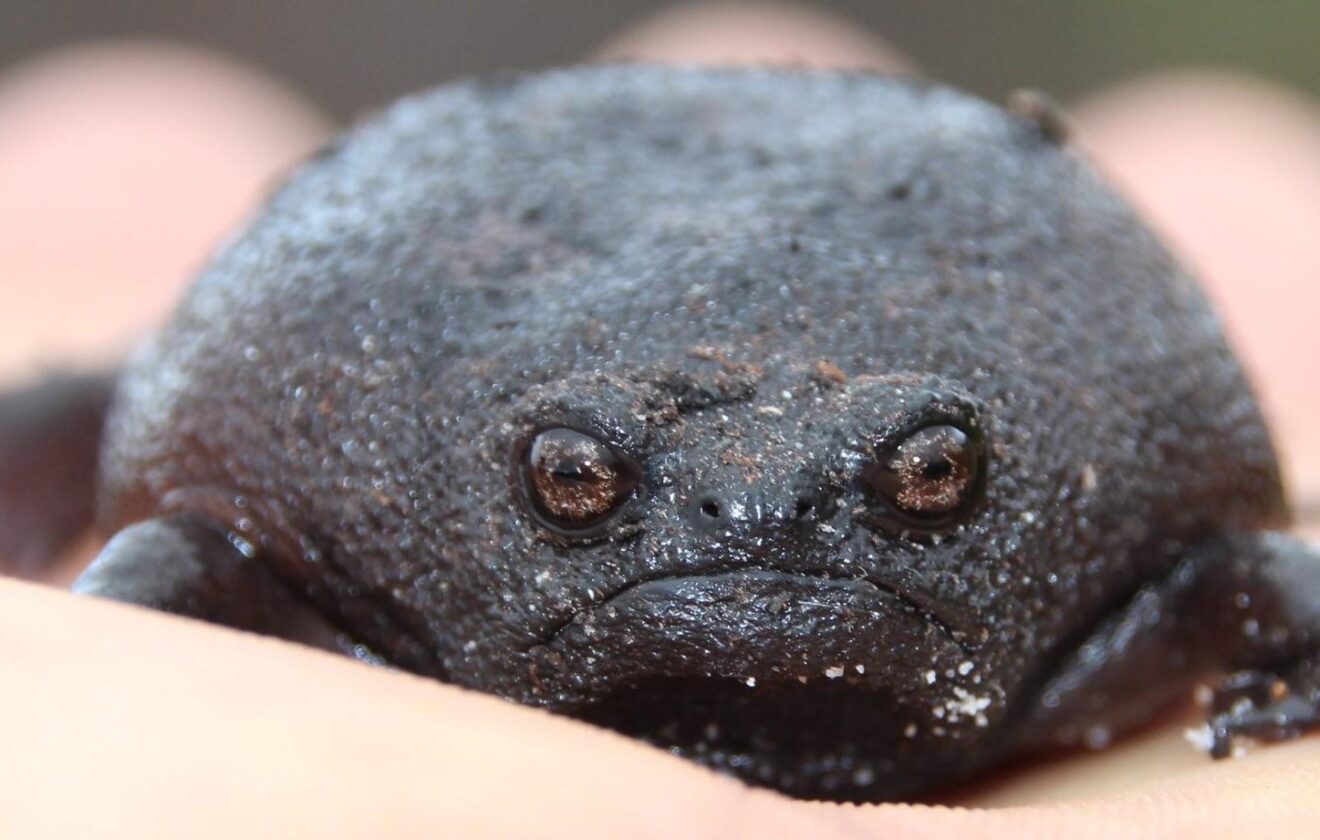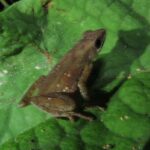The Marvelous Life of the Black Rain Frog (Breviceps fuscus)#
In the damp, mist-veiled forests and fynbos shrublands of South Africa, beneath carpets of moss and leaf litter, lives a tiny creature whose very presence reveals much about the health and secrets of its environment. Meet the Black Rain Frog, scientifically known as Breviceps fuscus, a peculiar amphibian cloaked in mystery, charm, and an undeniable quirkiness that has intoxicated naturalists and wildlife enthusiasts alike.
With its compact, round body, perpetually melancholy expression, and captivating behaviors, Breviceps fuscus is not your typical amphibian. This species has enthralled scientists and nature lovers alike, offering insights into evolutionary adaptation, ecological balance, and conservation challenges. Let’s delve deeper into its fascinating world.
Taxonomy and Classification#
The Black Rain Frog (Breviceps fuscus) belongs to the family Brevicipitidae, a group distinct within amphibian taxonomy. Unlike many frogs within Ranidae or Hylidae, characterized by their slender limbs and hopping agility, brevicipitid frogs possess stout bodies and extremely short limbs, adapted specifically for burrowing and terrestrial lifestyles.
The genus Breviceps itself comprises multiple closely related species, primarily found across southern Africa. Among them, Breviceps fuscus remains particularly unique both in its behavior and appearance, drawing a clear evolutionary path marked by adaptation to habitats rich in leaf litter and moist substrates.
Natural Habitat#
The Black Rain Frog is endemic to South Africa, primarily inhabiting the Cape Fold Mountains, coastal fynbos shrublands, and temperate forests of the Garden Route. Regions between Cape Town and Port Elizabeth form the epicenter of its distribution, an ecological zone defined by high humidity, consistent rainfall, and dense ground cover.
This species demonstrates a clear preference for microhabitats sheltered by leaf litter, rotting logs, and loose soil, where moisture retention is high and temperatures remain moderate. Rather than occupying visible water bodies like typical frogs, Breviceps fuscus has evolved an entirely terrestrial lifecycle, embedding itself within the moist layers of substrate to regulate temperature and protect its delicate skin.
Walking through these habitats, whether among tangled streamsides or beneath towering ancient trees blanketed with epiphytes and mosses, one rarely spots these frogs immediately. Instead, their concealed lifestyle necessitates careful observation, patience, and attentiveness to the damp nuances of their hidden world.
Physical Characteristics#
The Black Rain Frog is instantly recognizable by its peculiar, almost comically round body, barely exceeding 40 millimeters (approximately 1.6 inches) in length—about the size of a thumb tip. Its distinctive shape makes it appear perpetually inflated, earning amused comparisons to a tiny, sulky balloon.
Adding dramatically to this appearance, Breviceps fuscus has extremely short limbs, sturdy yet dwarfed by its corpulent form, markedly different from the extended jumping legs seen in many amphibians. Instead of hopping long distances, it relies heavily upon burrowing and crawling movements, enabling navigation through the dense, leaf-strewn forest floor.
Its coloration, often a deep, rich brown or grey-blackish hue interspersed with various shades, contributes elegantly to its camouflage. The species’ matte skin texture, speckled subtly with lighter flecks and occasional uneven patches of subdued brown, provides near-perfect invisibility amidst decaying leaves and woodland shadows. Its eyes are small, round, and dark, carrying an endearingly sorrowful expression that has charmed naturalists repeatedly.
Interestingly, when threatened or disturbed, the Black Rain Frog exhibits a unique behavior: inflating its body even more, forming a formidable and humorously grumpy ball that deters potential predators.
Behavior and Life Cycle#
Feeding Habits#
Being ground-dwelling and nocturnal, these enigmatic frogs tend to emerge from burrows under cover of darkness or following a significant rainfall. They venture above ground primarily for feeding, capitalizing upon the abundance of tiny invertebrates, such as termites, ants, beetles, spiders, and millipedes. Utilizing their rapid tongue movement, these frogs expertly capture a variety of prey items efficiently and swiftly within their leaf-covered domain. Their specialized diet heavily contributes to maintaining a healthy soil ecosystem in their terrestrial habitats.
Mating and Reproduction#
Perhaps one of the most fascinating and endearing features of Breviceps fuscus is its intimate mating behavior, which displays genuine tenderness uncommon among many amphibians. Unlike many frog species that engage in loud, chorus-style breeding near conspicuous water bodies, Black Rain Frogs adopt quiet and secluded rituals.
During mating season, a male selects an appropriate terrestrial burrow, where he vocalizes a gentle and deeply resonant call to attract potential mates. Once paired, an extraordinary event takes place: females produce sticky, transparent, spherical eggs directly in the shelter of the soil, negating any requirements of open water.
The most intriguing behavioral adaptation arises from the male’s exceptional parental dedication. Rather than departing post-fertilization, he remains alongside his partner, vigilantly guarding and maintaining humidity levels around the egg clutch. This remarkable parental investment significantly enhances offspring survival rates, demonstrating an evolutionary advantage in non-aquatic breeding conditions.
Tadpole Development#
Uniquely, Black Rain Frog offspring bypass traditional tadpole life-stages found in aquatic-breeding frogs. The larvae develop entirely within the protective eggs underground, emerging as fully-formed miniature froglets—a terrestrial adaptation key to thriving in their ecological niche. This life-stage journey highlights evolutionarily driven solutions that enable this species to exist independently from accessible open water.
Ecological Role#
Despite their small stature, Black Rain Frogs hold pivotal ecological positions within their Southern African ecosystems. Their prevalence as insectivores helps control pest populations and serves as a critical link in nutrient cycles, converting insect biomass into organic nutrients enriching the soil itself.
In turn, these diminutive frogs constitute important dietary sources for larger predators, including snakes, birds, small mammals, and even other amphibians. Their sensitivity to habitat degradation and moisture fluctuations makes them excellent bioindicators, signaling environmental health or distress.
Threats and Conservation Status#
Though currently classified as Least Concern by the IUCN Red List, the Black Rain Frog is not impervious to adversity. Habitat loss remains a substantial and growing threat facilitated by urban expansion, agriculture, deforestation, and logging activities. Pollution, climate-change-induced droughts, and altered rainfall patterns further exacerbate pressures upon their survival.
Fortunately, efforts targeting biodiversity conservation in South Africa’s protected areas, national parks, and biodiversity corridors actively safeguard these fragile yet vital habitats. Initiatives like habitat restoration, ecological research, and environmental education programs consistently integrate Black Rain Frogs as indicator species, enhancing local awareness and renewed conservation commitment.
Cultural and Scientific Significance#
Intriguingly, beyond scientific appreciation, the Black Rain Frog has achieved viral fame in popular media, admired worldwide for its captivating expressions and humorous behaviors illustrating charming anthropomorphism on social platforms. This accidental cultural elevation has notably heightened awareness of amphibian diversity, indirectly benefiting conservation dialogues.
Moreover, scientific research parsing the unique adaptations of this species continues to expand knowledge about amphibian resilience, terrestrial adaptability, and ecological roles. Understanding the biology of frogs like Breviceps fuscus can potentially inform broader conservation measures, assisting researchers in preserving less charismatic, yet ecologically critical, amphibian species worldwide.
Conclusion#
Breviceps fuscus, humble in size yet remarkable in adaptation, embodies the diverse beauty and interconnected intricacy of ecosystems that define southern Africa. Its delicate future depends upon active dedication and awareness among researchers, conservationists, policy-makers, and everyday advocates.
Exploring and learning more about species such as the Black Rain Frog not only nourishes our curiosity but strengthens our collective responsibility toward the natural world. As we venture forward together, let our understanding of this tiny amphibian inspire greater compassion, deeper connection, and amplified conservation actions dedicated to protecting our shared ecological heritage.















